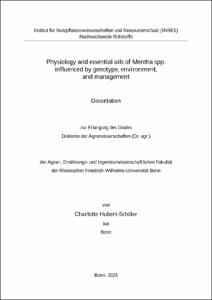Hubert-Schöler, Charlotte: Physiology and essential oils of Mentha spp. influenced by genotype, environment, and management. - Bonn, 2025. - Dissertation, Rheinische Friedrich-Wilhelms-Universität Bonn.
Online-Ausgabe in bonndoc: https://nbn-resolving.org/urn:nbn:de:hbz:5-86447
Online-Ausgabe in bonndoc: https://nbn-resolving.org/urn:nbn:de:hbz:5-86447
@phdthesis{handle:20.500.11811/13697,
urn: https://nbn-resolving.org/urn:nbn:de:hbz:5-86447,
doi: https://doi.org/10.48565/bonndoc-716,
author = {{Charlotte Hubert-Schöler}},
title = {Physiology and essential oils of Mentha spp. influenced by genotype, environment, and management},
school = {Rheinische Friedrich-Wilhelms-Universität Bonn},
year = 2025,
month = nov,
note = {Species of the genus Mentha are of high economic importance due to their versatile uses in food, cosmetics, and pharmaceutical industries. In particular, the essential oils (EOs) of Mentha are valued due to their aromatic and health-promoting properties. The increasing demand for high-quality EOs from mint requires a better understanding of the factors influencing plant growth and EO production. This dissertation therefore examines influences of genotype, environment, and management on physiological traits and the EO content and composition of different Mentha genotypes.
In a genotype screening, 20 Mentha genotypes were analysed with regard to plant growth, physiological parameters, and EO content. The results showed significant genotypic differences, which can serve as a basis for the selection and breeding of more efficient cultivars. Building on this, further experiments were carried out in which environmental and management factors such as increased UV-B radiation, shading by nets of different colours, and postharvest treatments were specifically investigated in three Mentha genotypes. Increased UV-B radiation elevated the EO content in all three Mentha genotypes that were investigated. Shading, on the other hand, promoted vegetative growth. As Mentha is traditionally grown outdoors and higher temperature and increased UV radiation could be expected due to climate change, shading was used as a factor in an outdoor trial. The results showed a slight increase in the EO content under shading. Coloured shading nets (blue and red) were used for further experiments. These also had an influence on the EO composition. Red nets favoured a higher p-menthone content, blue nets a higher carvone content. However, an investigation of two postharvest treatments (separation of leaves and stems before or after drying) showed no influence on EO content and composition.
In summary, the results of this dissertation make an important contribution to further research projects by describing the complex interactions between genotype, environment, and management in Mentha genotypes. They show that a targeted selection of suitable Mentha genotypes and an adapted cultivation strategy can have a decisive influence on the quality of EOs. They offer practical approaches for farmers for optimising EO production and open up new perspectives for resource-efficient use.},
url = {https://hdl.handle.net/20.500.11811/13697}
}
urn: https://nbn-resolving.org/urn:nbn:de:hbz:5-86447,
doi: https://doi.org/10.48565/bonndoc-716,
author = {{Charlotte Hubert-Schöler}},
title = {Physiology and essential oils of Mentha spp. influenced by genotype, environment, and management},
school = {Rheinische Friedrich-Wilhelms-Universität Bonn},
year = 2025,
month = nov,
note = {Species of the genus Mentha are of high economic importance due to their versatile uses in food, cosmetics, and pharmaceutical industries. In particular, the essential oils (EOs) of Mentha are valued due to their aromatic and health-promoting properties. The increasing demand for high-quality EOs from mint requires a better understanding of the factors influencing plant growth and EO production. This dissertation therefore examines influences of genotype, environment, and management on physiological traits and the EO content and composition of different Mentha genotypes.
In a genotype screening, 20 Mentha genotypes were analysed with regard to plant growth, physiological parameters, and EO content. The results showed significant genotypic differences, which can serve as a basis for the selection and breeding of more efficient cultivars. Building on this, further experiments were carried out in which environmental and management factors such as increased UV-B radiation, shading by nets of different colours, and postharvest treatments were specifically investigated in three Mentha genotypes. Increased UV-B radiation elevated the EO content in all three Mentha genotypes that were investigated. Shading, on the other hand, promoted vegetative growth. As Mentha is traditionally grown outdoors and higher temperature and increased UV radiation could be expected due to climate change, shading was used as a factor in an outdoor trial. The results showed a slight increase in the EO content under shading. Coloured shading nets (blue and red) were used for further experiments. These also had an influence on the EO composition. Red nets favoured a higher p-menthone content, blue nets a higher carvone content. However, an investigation of two postharvest treatments (separation of leaves and stems before or after drying) showed no influence on EO content and composition.
In summary, the results of this dissertation make an important contribution to further research projects by describing the complex interactions between genotype, environment, and management in Mentha genotypes. They show that a targeted selection of suitable Mentha genotypes and an adapted cultivation strategy can have a decisive influence on the quality of EOs. They offer practical approaches for farmers for optimising EO production and open up new perspectives for resource-efficient use.},
url = {https://hdl.handle.net/20.500.11811/13697}
}





